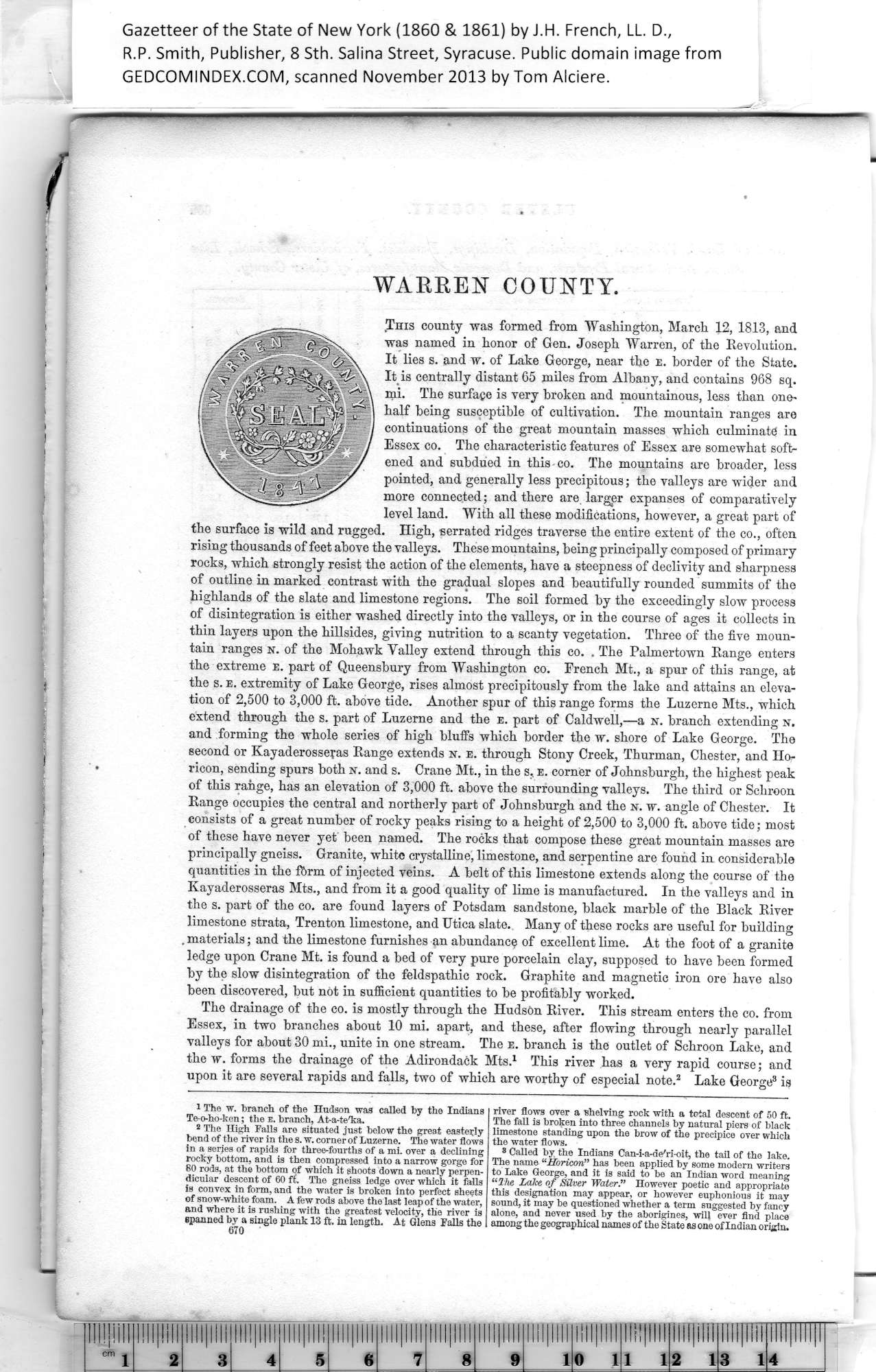|
WARREN COUNTY.
This county was formed from Washington, March 12, 1813, and
was named in honor of Gen. Joseph Warren, of the Revolution.
It lies s. and w. of Lake George, near the e. border of the State.
Itis centrally distant 65 miles from Albany, and contains 968 sq.
mi. The surface is very broken and mountainous, less than one-
half being susceptible of cultivation. The mountain ranges are
continuations of the great mountain masses which culminate in
Essex co. The characteristic features of Essex are somewhat soft¬
ened and subdued in this co. The mountains are broader, less
pointed, and generally less precipitous; the valleys are wider and
more connected; and there are larger expanses of comparatively
level land. With all these modifications, however, a great part of
the surface is wild and rugged. High, serrated ridges traverse the entire extent of the co., often
rising thousands of feet above the valleys. These mountains, being principally composed of primary
rocks, which strongly resist the action of the elements, have a steepness of declivity and sharpness
of outline in marked contrast with the gradual slopes and beautifully rounded summits of the
highlands of the slate and limestone regions. The soil formed by the exceedingly slow process
of disintegration is either washed directly into the valleys, or in the course of ages it collects in
thin layers upon the hillsides, giving nutrition to a scanty vegetation. Three of the five moun¬
tain ranges n. of the Mohawk Yalley extend through this co. . The Palmertown Range enters
the extreme E. part of Queensbury from Washington co. French Mt., a spur of this range, at
the s. e. extremity of Lake George, rises almost precipitously from the lake and attains an eleva¬
tion of 2,500 to 3,000 ft. above tide. Another spur of this range forms the Luzerne Mts., which
extend through the s. part of Luzerne and the e. part of Caldwell,—a n. branch extending n.
and forming the whole series of high bluffs which border the w. shore of Lake George. The
second or Kayaderosseras Range extends n. e. through Stony Creek, Thurman, Chester, and Ho-
ricon, sending spurs both n. and s. Crane Mt., in the s.. e. corner of Johnsburgh, the highest peak
of this range, has an elevation of 3,000 ft. above the surrounding valleys. The third or Schroon
Range occupies the central and northerly part of Johnsburgh and the n. w. angle of Chester. It
consists of a great number of rocky peaks rising to a height of 2,500 to 3,000 ft. above tide; most
of these have never yet been named. The rocks that compose these great mountain masses are
principally gneiss. Granite, white crystalline, limestone, and serpentine are found in considerable
quantities in the fbrm of injected veins. A belt of this limestone extends along the course of the
Kayaderosseras Mts., and from it a good quality of lime is manufactured. In the valleys and in
the s. part of the co. are found layers of Potsdam sandstone, black marble of the Black River
limestone strata, Trenton limestone, and Utica slate. Many of these rocks are useful for building
. materials; and the limestone furnishes an abundance of excellent lime. At the foot of a granite
ledge upon Crane Mt. is found a bed of very pure porcelain clay, supposed to have been formed
by the slow disintegration of the feldspathic rock. Graphite and magnetic iron ore have also
been discovered, but not in sufficient quantities to be profitably worked.
The drainage of the co. is mostly through the Hudson River. This stream enters the co. from
Essex, in two branches about 10 mi. apart, and these, after flowing through nearly parallel
valleys for about 30 mi., unite in one stream. The e. branch is the outlet of Schroon Lake, and
the w. forms the drainage of the Adirondack Mts.1 This river has a very rapid course; and
upon it are several rapids and falls, two of which are worthy of especial note.2 Lake George2 is
|
river flows over a shelving rock with a total descent of 50 ft.
The fall is broken into three channels by natural piers of black
limestone standing upon the brow of the precipice over which
the water flows.
8 Called by the Indians Can-i-arde'ri-oit, the tail of the lake.
The name “Horicon” has been applied by some modern writers
to Lake George, and it is said to be an Indian word meaning
“2he Lake of Silver Water.” However poetic and appropriate
this designation may appear, or however euphonious it may
sound, it may be questioned whether a term suggested by fancy
alone, and never used by the aborigines, will ever find place
among the geographical names of the State as one of Indian origin. |
1
The w. branch of the Hudson was called by the Indians
Te-o-ho-ken; the e. branch, At-a-teTia.
2
670
|
